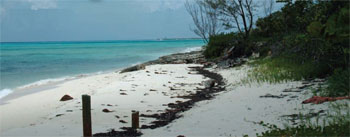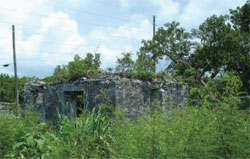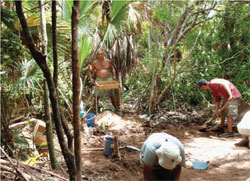Nestled in a dry tropical forest on the western shores of New Providence Island the Clifton plantation has for centuries been remote from the hustle and bustle of Nassau. The plantation dates to the late 18th century and at that time it was a four-hour ride on horseback into the city of Nassau. The Clifton plantation is of special interest because William Wylly once owned it. Wylly was the Attourney General of The Bahamas, and a very controversial character. Wylly is often portrayed as one of the more benevolent slave owners, if benevolence is a term we can apply to slavery. He encouraged his slaves to marry, and in return he built them their own houses. In addition, his overseer for the plantation was of African origin, and also the pastor of a local church that served the African community.

Photo by Michael Dion
As one approaches the plantation along the north coast from Nassau there are eight stone buildings that served as the homes for Wylly’s married slaves. These buildings are in relatively good condition, although their roofs have deteriorated. Next,one comes to the remains of the stable. Across the street is the great house, which burned and collapsed in 1851. There are numerous stonewalls crossing the property and two other stone buildings close to the beach. One of these buildings apparently was a tavern and continued in use until the 1960s. These two buildings may predate Wylly’s ownership and may have served as quarters for unmarried slaves when Wylly owned the property.
Laurie Wilkie of the University of California, Berkeley, and Paul Farnsworth, of Louisiana State University, conducted archaeological investigations at Clifton in the late 1990s. Their work focused on the plantation, and emphasized excavations in the house yards of the married slave quarters. Their investigations provide a fascinating portrait of the enslaved peoples who lived at the Clifton plantation, including accounts of their African origins (Sampling Many Pots, University Press of Florida, 2004).

Photo by Michael Dion
The plantation period in The Bahamas is associated with “Loyalists” who fled the United States following the Revolutionary War (War of Independence). Their main focus in The Bahamas was the production of cotton, which declined rapidly due to impoverished soils, boll weevil infestations, and a series of devastating hurricanes. Within 20 years (between about 1780 and 1800) the Loyalist economy collapsed, and many landowners abandoned their plantations and returned to England. In many cases their slaves were left to fend for themselves.
During the course of their investigations Wilkie and Farnsworth also discovered evidence Clifton was occupied during the Conch Period. This is the time before the arrival of the Loyalists when Nassau was home to freebooters and buccaneers. They also found pre- Columbian artifacts that signaled evidence for two Lucayan Indian sites that were radiocarbon dated to around AD 1100. In sum, the Clifton property holds historical evidence for human occupation beginning about 900 years ago and continuing to the present.
The Florida Museum of Natural History and The Bahamas Antiquities, Monuments and Museums Corporation, which oversees archaeological research in its islands, have signed a memorandum of understanding. As part of this arrangement, an expedition financed by the Clifton Heritage Authority was mounted by the Florida Museum August 2006 to more fully investigate the Lucayan Indian settlement in the park. William Keegan directed the project.

Photo by Michael Dion
The Florida Museum expedition succeeded in defining the boundaries of the Lucayan site, and provided conclusive evidence that this was one large archaeological deposit, and not two sites as previously interpreted. The archaeological deposits are relatively thin and additional research is needed to determine whether this was one, large, short-lived village, or a series of small settlements occupied over a period of at least two centuries. The deposits are of special interest because they contain a substantial amount of decorated pottery, which is unusual at Lucayan sites.
The beach at Clifton has for years been a popular weekend retreat, but as development intensified on the island the property became the target of developers who planned to exclude the public, and develop a gated community and golf course. The integrity of the Clifton plantation was threatened by private developers despite its historical significance. The public outcry was palpable. There were town meetings in 2005, and the government resolved to purchase the property and create the Commonwealth of the Bahamas first national heritage park. The park, scheduled to open to the public in spring 2008, features interpretive signs and a trail system through the varied environments, including a “Lucayan trail.” The plantation buildings have been cleared of vegetation, and historical stabilization and reconstruction is underway. Future plans include the construction of a visitor center and museum. The Florida Museum is proud of its contributions to the cultural patrimony of The Bahamas, and encourages anyone who visits Nassau to make the effort to visit this extraordinary national heritage park.
Dr. William Keegan is Curator of Caribbean Archaeology at the Florida Museum of Natural History. Dr. Keith Tinker is Director of the Antiquities, Monuments and Museums Corporation and Secretary to the Clifton Heritage Authority, and Dr. James Miller is the planner for Clifton Heritage Park.
Learn more about the Caribbean Archaeology Collection at the Florida Museum.